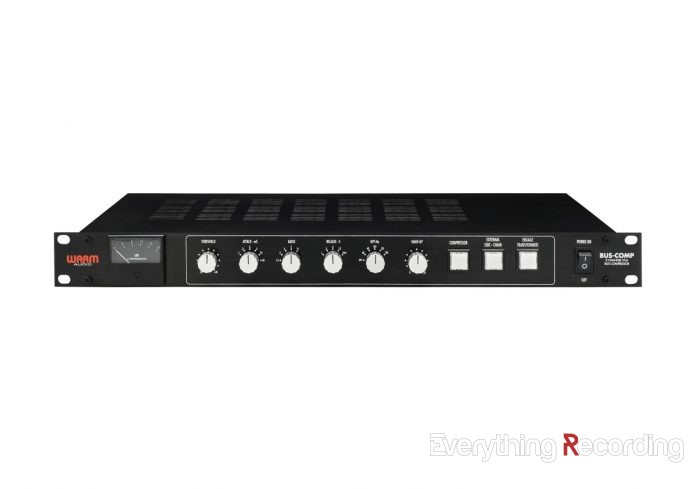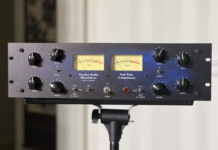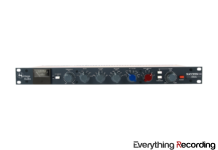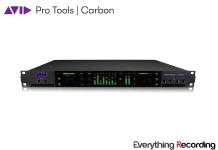- HPF sidechain lets you keep the low end intact
- Sonically impeccable signal path
- Built like a tank with a sound to match
- Output transformers really need to be driven to hear a difference
- If you have the actual SSL, you paid $2800 too much
We’re pretty fond of our writing but for the illiterate or impatient, Click HERE to get straight to the audio at the bottom of the review.
British By Birth. Texas-Size Tone
Warm Audio’s latest entry in the world of analog compression takes inspiration from one of professional recording’s most famously used pieces of hardware: The stereo bus compressor from Solid State Logic’s large format consoles. Though certainly not the only high-end compressor available, it’s rightfully earned its place as many engineers’ immediate “go-to”.
Often referred to as “the glue”, this design has an almost mythical ability to put meat on the bones of even the skinniest of mixes. Elements that won’t “sit right” suddenly fold their napkins politely in their lap. Untamable Kilimanjaro-esque peaks become a bunny hill. And, for once, every member of the band stops saying they need to be louder (for an hour or two at least).
Meet The WA-Bus Compressor
That’s the sound that Austin, TX-based Warm Audio has set out to bring within reach of every even halfway-serious studio.The Warm Audio Bus Compressor is exactly what it says on the tin. Strapped across a stereo mix or subgroup, the Bus-Comp delivers a first-class, totally analog path of gluey squish, squeeze and polish. Priced at an almost-TOO-reasonable MSRP of $699, this is designed to do “that thing”… and it does the crap out of it.
Though the Bus-Comp may have some British DNA, a quick look reveals inside and out reveals as many similarities as it does differences. Housed in a sturdy black 1U steel chassis, the stereo-only unit keeps controls to just a dummy-proof set of bare necessities. Six sturdy detented knobs click in the “usual suspects” parameters – but with the addition of a selectable highpass sidechain frequency.
Wait, did you just say “sidechain frequency”?
A frequent critique of this style of compressor is the lack of an internal high-pass filter for sidechaining the detection circuit. Even SSL’s own stereo rack-mount version costing thousands more overlooks what is a very critical part of using this compressor to its fullest potential.
If you’re scratching your head at some of this, we’ll lay it out quickly (or you can check the glossary at the end): A compressor’s RMS detection circuit is triggered by the full spectrum of a mix. However, amplitude from bass-heavy instruments like kick drums, subs and low-end bass notes can force the compressor into what’s often called “pumping” or “breathing”. Cool for an occasional effect? Sure. Cool for your whole stereo mix? Probably not..
Setting a variable high-pass filter as a sidechain tells the compressor to “ignore” the rumble in the jungle below a certain point. The Bus Comp lets you dial this in all the way from 0 (off) to 185hz in roughly 30hz steps, more than enough range to find the sweet spot – letting the kicks and subs occupy their own crucial space below deck without sucking the other elements down with it.
Oh, The Iron-y
The Bus-Comp features a switchable discrete op-amp stage with two chonkin’ USA-made Cinemag iron 1:1 transformers. When engaged, the intent is to give the soundstage depth, while bringing out pleasing, subtle second- and third-order harmonics. When slapped around with too much signal activity at once, things can get wild and wooly – but not in a bad way.
This is the sort of thing that has given birth to dozens of nebulous audio industry buzz-words: “Depth”, “Warmth”, “Heat” and the dreaded “Mojo” come to mind. Warm Audio had the flash of genius to make this accessible at the push of a button, letting the user quickly decide between the two. Is it right for each application? Well, that’s why there’s an on/off button.
Warming It Up
Setting up the Warm Audio Bus Compressor is a fairly standard affair, with a beefy internal power supply fed by the included IEC cable. Inputs and outputs are available interchangeably on balanced TRS ¼” and XLR connectors, with the sidechain input on XLR only. Rack it up, plug it in, flip the switch on the front panel and the Bus-Comp is ready to go to work.
Getting your basic settings is the same here as it is with most other compressors, whether they cost half or twenty times as much. Bring your threshold down to just above where the gain reduction meter shows the compressor engaging with the attack and ratio at twelve o’ clock. Begin pulling the threshold down while simultaneously bringing the make-up gain up, keeping an eye on the meter to see just how much, and where, the Bus Comp is working. It’s important to keep switching the unit in and out to compare the compressed and uncompressed signals.
Some engineers (and I count myself among them), pull the threshold down until the circuits cry uncle and use that to dial in the attack and release times, as well as where to engage the sidechain (if at all). Then? Bring the threshold back to the land of the living and promise that you “won’t be that volume war guy”. Not today, at least.
Getting On The Bus
The other decision to be made here of course, is WHAT stereo bus is being compressed. The Bus-Comp doesn’t play favorites – and it’s just as happy to tighten the leash on your stereo mix as it is a drum bus, guitar, synths, drum overheads, room mics, vocal submixes, or any other source you desire. You could use it as a mono unit on things like bass guitar or synth – just remember that this IS a stereo only compressor without dual-mono operation.
Let’s Get This Bus Rolling
I set the Bus-Comp up as a hardware effect insert in Steinberg Cubase Pro, allowing me to quickly assign (and time-align) the unit on any stereo source in the mixer. Pulling up a mix project I’m doing for a particularly “punchy” metal-type band, I was eager to see how it performed… especially compared to similar plug-ins and hardware compressors in my rack.
Notably, the Bus-Comp was sharing space with one of my own GSSL builds using the original DBX 202 “Blackmer” VCA, as well as Cytomic’s “The Glue” and Waves’ SSL 4000 G Bus Compressor plug-ins. All close cousins of the unit being reviewed today, and all processors I am as intimately familiar with as I am the actual SSL console itself.
Observations
The very first thing I noticed is just how well the Bus-Comp exemplifies that famous, ‘grabby’ VCA sound. At lower (dare I say ‘normal’?) compression ratios and higher thresholds, the Bus-Comp efficiently and transparently tames peaks in the material while pulling up the space between the notes in a very musical, pleasing way. You won’t necessarily hear the compressor “working” with more conservative settings, but you’ll certainly miss it once it’s switched out, like getting out of a hot shower on a freezing cold morning.
I tried the Bus-Comp on a stereo pair of room mics spaced about 14 feet from the kit in a medium room that had been recorded through a pair of OktavaMod mk12’s. Instantly the room began to breathe more after every kick, hit and crash – stepping aside for the transient and falling in back on itself to give the overall kit sound some snark and presence. That’s certainly not a way you typically describe the way a metal band’s drum mix sounds in this day and age, but it was a refreshing change to hear the drums sound just a little bit more like, uh… drums.
On Drums
On the drum sub-mix, I high-passed out away the lowest registers of a particularly chesty 24″ kick drum, finally landing at 125hz, effectively splitting the drum’s effect on the compressor in half. Above that, the separation was just a little too… separate. Hearing the transients push the overheads out of the way then letting the cymbals and room wash back ashore gave the drums a huge presence in the mix – a previously unrealized bit of Bonhamesque bombast.
Switching in the transformers, things like the cymbal overtones became less “shrieky” and I found myself opening back up a few channels’ low-pass filters a bit. The highest discernible octave (9-18kHz) became less splattered and I felt much more confident that the mix wouldn’t blow out on “hyped” consumer playback systems.
On Guitars
Just for grins, I also strapped the Bus-Comp across the guitar submix (a grand total of four tight-miked cabinets over two separate performances). Sending the kick, snare and tom attacks to spike the compressor let me pull the guitars closer – though it was easy to overdo. I wound up just triggering one each of the cabinet mics and letting the other two stay constant. Tricks like this means less compression on the stereo mix.
Now that we’ve talked about how the Bus-Comp plays nice, let’s ponder for a moment how good it is when it’s used less responsibly. Pull the threshold and gun it on the ratio and we’re dealing with a whole new beast. Pushed into “compression as an effect”-land, it fights dirty. Like, stilettos in a back-alley dirty. A ho-hum drum mix becomes your new favorite loop. A bass synth with an aggressive ratio keyed off the bass drum will make EDM producers leap in literal ecstasy. A band-passed vocal getting spanked by this thing catapult the singer’s words into the listener’s nightmares.
As I only had the one unit, I printed some drum and guitar mults for safety and turned it back on the stereo bus. Of course, by now I had been mixing a metal track all day while getting giddy on new-gear-syndrome, so my ears were just a wee bit fatigued. But even after just a day in session, it’s needless to say the Warm Audio Bus Compressor has earned its place. I took that drummer’s advice and let the Warm Audio guys that this one would not be coming back..
Okay, So What’s Missing?
Sigh. Having cut my baby teeth on compressors half this good for twice as much, I would have to say “absolutely nothing.” It’s really that good, especially when you realize just how on-the-level it is with similar units costing five times more (and don’t have the HPF or transformers… which are VERY nice to have).
Price aside, I would have happily paid another $100 to have a “mix” knob, allowing parallel compression from right inside the box. Of course, when doing parallel compression in most DAW setups, you have the flexibility to automate the levels from section to section, which really helps bring out the dynamics of a solid drum mix. Still, it’d be a nice-to-have for those “set and forget” situations.
My only other niggle was that the VU only displays gain reduction and not input or output level. For those of us who are used to monitoring off our DAW’s display it’s maybe not so big a deal, but I can think of a mastering engineer or two who would be most displeased (you know how mastering engineers are, fainting on their tea sets over this sort of thing).
The Only Game In Town? Welllll……..
So let’s be real here – this design, this “thing” has been done before – and we don’t just mean by the people who make the original. It’s been done by the people who designed the original, too (the Alan Smart C1 or C2). And it’s been faithfully recreated by the TK Audio BC 1, the Dramastic Obsidian and the thousands of brave DIY-ers who’ve tackled the Gyraf SSL DIY build.
But for literally one fifth the price of the SSL XLogic G, you could just wait a couple days for the Men in Brown and enjoy your new rack candy from an established company with a solid warranty and great people backing it up.
Why Hardware? I’ve Got A Plug In!
Of course you do. So do I. They’re cheaper, you can use as many as your CPU’s resources allow and they don’t take up rack space or require a bigger interface. Hardware can’t easily be automated. I get it. It’s been over twenty years since the first modelling plug-ins began to appear. Back then the graphics were novel, the sound was hideous and even the best computers would be dragged to their knees. But plug-ins and emulation have reached the point where the difference is so near-undetectable that the simplicity, price and ease-of-use certainly justify the trade off of some minor differences.
The majority of engineers and producers I know use both. Plug-ins for the utility infielder duty, outboard for those special times where it matters. Think of it like dishes, or underwear. If you’re on the fence about adding your first or fifth piece of analog kit to your largely DAW setup, the Bus-Comp is an excellent addition. Having an analog path to create an analog effect is simply using the right tool for the job.
The Real, Real, Real Review
In all fairness, every type of compressor has one or two applications that they excel at and others for which they’re not as ideal. The DBX160 is a monster for bass, but I wouldn’t necessarily reach for it on a snare. The LA2A kills it on vocals, but I’ve never cared for using two on a stereo mix (this is subjective, of course). Though it’s a stereo design, I’d have to say though, the Bus-Comp is versatile and you could most certainly make it work on just about anything.
That aside, I don’t have a lot of room for new gear (NYC studios are like that). For something to earn a coveted space in my arsenal, it’s got to be unique or do one thing that other things can’t. Frankly I’ve got more than enough compressors (both virtual and real) than I need – including ones very similar to the Bus-Comp. But it’s an inventive, versatile facelift of a British legend that adds two extremely functional upgrades. It’s built like a tank with the sonics to match at an extremely handsome price.
Put it this way, if the WarmAudio Bus Compressor cost twice as much? I’d still have kept it. It’s really that good.
And Now, The Audio
In order to better get a sense of how the BUS-COMP faired against others (both hardware and software), we took three different tracks and ran each through their respective gear.
The Contestants:
The files below are labelled accordingly
- Dry is… dry
- GSSL is a GSSL with turbo mod and DBX 202 Gold-Can VCA’s
- WarmAudio is… well you get the idea
- Waves Plug In is the Waves 4000 G Channel Stereo Compressor
The Tracks:
- “ATF” is a drum track you may recognize
- “BleedingHeartSonatas” is from Revenge Fetish
- “Encoder” is by Maxipok (for more of their music visit their SoundCloud)
The Approach
To bring out each compressor’s tone, thresholds were lowered more than usual, with slow attacks and fast releases. Levels were matched to the best of our ability to equal the playing field.
ASK AN ADULT – THE GLOSSARY SECTION FOR PEOPLE WHO NODDED ALONG POLITELY BUT DIDN’T KNOW THINGS MEANT
VCA: Voltage Controlled Amplifier / Attenuator. A transistor that raises or lowers incoming signal according to a “control voltage”. In other words, the part of the compressor that does the compressing. VCA’s are one of several “classic” compressor elements, including photo-resistors, FET (field effect transistor) tubes and diode bridges
RMS Detector / Comparator: The section of the compressor that “listens” and decides (based on a user-defined threshold). “Feed back” designs like the Bus-Comp are activated post-VCA and tend to sound ‘smoother’, while “feed forward” are placed before the VCA and tend to be more ‘obvious’ sounding.
“Keying” or “Side-Chaining”: Activating a compressor’s VCA with audio that is not the incoming signal. In the case of HPF side-chaining, the signal that activates the comparator/detector has had low-end removed, making the compressor only activated by signal above a certain frequency.
DBX 202 / “Blackmer” VCA: One of the original Integrated Circuit (IC) VCA’s, designed by David Blackmer of DBX, whose microelectronics division went on to become the THAT corporation. The DBX 202 was in the original SSL 4000E console’s compressor and, just as famously, the DBX 160. Subsequent revisions of the same design, like the THAT2180 and 2182 appeared in later applications, like the one reviewed today.
Transformers: Robot toys from your youth that could transform from ordinary items like cars and boom boxes. But, in the context of pro audio they’re big square horseshoe-esque pieces of iron, steel or nickel which create a magnetic field between the input winding on one side and output winding on the other. The amount of windings on each side create a ratio that brings the level up or down, adding a harmonic-rich artifact that is considered a hallmark of classic preamps, eq’s and compressors.
For more information and to buy, visit our link HERE.














